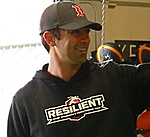Jumping and Landing Progressions for Volleyball Players
By: Jason Maher, C.S.C.S.
Jumping and landing progressions for volleyball players are obviously much-needed skills that have to be practiced. From a strength and conditioning perspective training the landing portion of jumping is much more important. As strength and conditioning coaches, our job is to prepare our athletes for the demands of their sport. In this case, preparing them to be able to absorb and mitigate the forces produced as a byproduct of jumping.
This article coincides with a four minute instructional video I put together. The video is designed to walk through the jumping and landing progressions I use with my volleyball players. Keep in mind that the point of my jumping progressions is to introduce jumping and landing at a rudimentary level. Then, progressively challenge the athlete as the jumps increase in difficulty.
Look for Quality First
Before I increase the complexity of the drill I am looking to see if the athlete has mastered the prerequisite jump and can safely move forward. The specifics that I am looking for in a landing is that the athlete can control their body weight and absorb the force from falling. I am watching to make sure the knees are tracking over the center toes, the athlete is landing soft, and they maintain an athletic position upon landing. This will prepare them for multiple jumps and hops in the future.
At this stage of development, the hurdle height is less important to me. I am not asking my athletes to clear a certain height. Instead, I am giving them visual feedback as to where I want them to land. As the athlete progresses through their development, I will start to alter hurdle height. I do prefer lower hurdles to begin the teaching process, however. With a lower hurdle height, I find it easier for the athlete to focus on their landing verses the goal of getting over an obstacle.
It is always easier to add variance in the future rather than trying to recover from assigning a task too early that the athlete is not ready for. At any stage of these progressions, you as a coach, can slow the movement down and break it into pieces. For the purpose of this video, I only broke down the first jump into 3 stages. The best way to simplify these jumping drills is to break down each part of the movement by adding pauses. For instance, as in the first jump in the video I ask the athlete to snap down and hold, jump, land and hold, then reset for the next jump. I can slow down the process with any variation of these jumps. This is to make sure the athlete is focusing on where they need to improve.
A Few Words on Volume
Remember to keep the volume of jumps in your training programs on the lighter side, especially when you are introducing new jumps and hops to your athletes. I start with 2 to 3 sets of 4 to 6 jumps and move on. I will in most cases keep the set and rep ranges the same and increase difficulty by progressing the drill, however, if the athlete is more advanced or needs an additional stimulus I will increase volume slightly as well.
About the Author
 Jason Maher is a strength and conditioning coach and the founder of Resilient Strength and Conditioning located in Carlsbad, California. Resilient S and C works primarily with high school and college female athletes involved in lacrosse, field hockey, soccer, softball, beach volleyball, and surfing. Jason is a certified strength and conditioning specialist as well as a club sport coach through USAW. He holds various other strength and conditioning credentials. He also holds certifications through the NSPA in nutrition, program design, weightlifting, and speed and agility. Jason has worked with youth athletes of all ages, professionals, Olympians, and now focuses on the high school and college athlete.
Jason Maher is a strength and conditioning coach and the founder of Resilient Strength and Conditioning located in Carlsbad, California. Resilient S and C works primarily with high school and college female athletes involved in lacrosse, field hockey, soccer, softball, beach volleyball, and surfing. Jason is a certified strength and conditioning specialist as well as a club sport coach through USAW. He holds various other strength and conditioning credentials. He also holds certifications through the NSPA in nutrition, program design, weightlifting, and speed and agility. Jason has worked with youth athletes of all ages, professionals, Olympians, and now focuses on the high school and college athlete.
Recommended Athletes Acceleration Products
 | |
| Complete Program Design |




0 Comments for “Jumping and Landing Progressions for Volleyball Players”